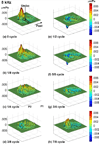Motion of the surface of the human tympanic membrane measured with stroboscopic holography
- PMID: 20034549
- PMCID: PMC2866839
- DOI: 10.1016/j.heares.2009.12.024
Motion of the surface of the human tympanic membrane measured with stroboscopic holography
Abstract
Sound-induced motion of the surface of the human tympanic membrane (TM) was studied by stroboscopic holographic interferometery, which measures the amplitude and phase of the displacement at each of about 40,000 points on the surface of the TM. Measurements were made with tonal stimuli of 0.5, 1, 4 and 8 kHz. The magnitude and phase of the sinusoidal displacement of the TM at each driven frequency were derived from the fundamental Fourier component of the raw displacement data computed from stroboscopic holograms of the TM recorded at eight stimulus phases. The correlation between the Fourier estimates and measured motion data was generally above 0.9 over the entire TM surface. We used three data presentations: (i) plots of the phasic displacements along a single chord across the surface of the TM, (ii) phasic surface maps of the displacement of the entire TM surface, and (iii) plots of the Fourier derived amplitude and phase-angle of the surface displacement along four diameter lines that define and bisect each of the four quadrants of the TM. These displays led to some common conclusions: at 0.5 and 1kHz, the entire TM moved roughly in-phase with some small phase delay apparent between local areas of maximal displacement in the posterior half of the TM. At 4 and 8 kHz, the motion of the TM became more complicated with multiple local displacement maxima arranged in rings around the manubrium. The displacements at most of these maxima were roughly in-phase, while some moved out-of-phase. Superposed on this in- and out-of-phase behavior were significant cyclic variations in-phase with location of less than 0.2 cycles or occasionally rapid half-cycle step-like changes in-phase. The high frequency displacement amplitude and phase maps discovered in this study can not be explained by any single wave motion, but are consistent with a combination of low and higher order modal motions plus some small traveling-wave-like components. The observations of the dynamics of TM surface motion from this study will help us better understand the sound-receiving function of the TM and how it couples sound to the ossicular chain and inner ear.
Copyright (c) 2009 Elsevier B.V. All rights reserved.
Figures









References
-
- Decraemer WF, Khanna SM, Funnell WR. Interferometric measurement of the amplitude and phase of tympanic membrane vibrations in cat. Hear Res. 1989;38(1–2):1–17. - PubMed
-
- Decraemer WF, Khanna SM, Funnell WR. Vibration at a fine grid of points on the cat tympanic membrane measured with a heterodyne interferometer. EOS/SPIE Int Sym, Munchen. 1999
-
- Fay J, Puria S, Decraemer WF, Steele C. Three approaches for estimating the elastic modulus of the tympanic membrane. J Biomech. 2005;38:1807–1815. - PubMed
-
- Fletcher NH. Acoustic Systems in Biology. New York: Oxford Univ. Press; 1992.
Publication types
MeSH terms
Grants and funding
LinkOut - more resources
Full Text Sources
Other Literature Sources

